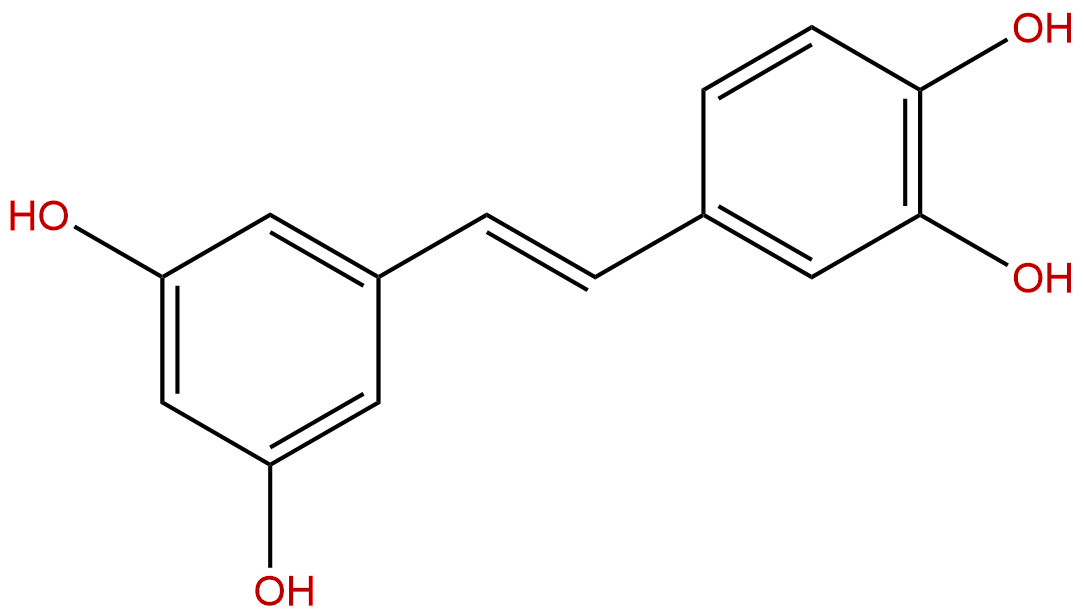Piceatannol Descrtption
Product name: Piceatannol
Synonym name:
Catalogue No.: BP1525
Cas No.: 10083-24-6
Formula: C14H12O4
Mol Weight: 244.246
Botanical Source: Found in Norway spruce, Vouacapoua macropetala, Pericopsis angolensis and other spp. Constit. of peanuts, Vaccinium sp. berries and grapes
Physical Description: Powder
Type of Compound: Stibene glucosides
Purity: 95%~99%
Analysis Method: HPLC-DAD or/and HPLC-ELSD
Identification Method: Mass, NMR
Packing: Brown vial or HDPE plastic bottle
Storage: Store in a well closed container, protected from air and light. Put into refrigerate or freeze for long term storage.
Whenever possible, you should prepare and use solutions on the same day. However, if you need to make up stock solutions in advance, we recommend that you store the solution as aliquots in tightly sealed vials at -20℃. Generally, these will be useable for up to two weeks.
The product could be supplied from milligrams to grams, up to kilograms
Inquire for bulk scale.
Descriptions:
Piceatannol , a resveratrol analogue, is a polyphenol present in the skins of grapes and in wine and other foods, it inhibits proliferation and migration of VSMC treated with TNF-α, therefore, piceatannol may be an effective therapeutic approach to treat atherosclerosis.[1]
Piceatannol inhibits the antigen-stimulated tyrosine phosphorylation of Syk and inhibit mast cell Fc epsilon R1-mediated signaling and effector function.[2]
Piceatannol is a closely related stilbene that has antileukaemic and anti-cancer activity, it is converted from resveratrol by the cytochrome P450 enzyme CYP1B1;resveratrol, as well as the hydroxylated analog piceatannol, are potent inducers of apoptotic cell death in BJAB Burkitt-like lymphoma cells with an ED50 concentration of 25 microM; piceatannol is a very efficient inducer of apoptosis in this ex vivo assay with leukemic lymphoblasts of 21 patients suffering from childhood lymphoblastic leukemia.[3,4]
Piceatannol sensitizes TRAIL-induced-apoptosis via Sp1- and ERK-dependent DR5 up-regulation. [5]
Piceatannol is an anti-inflammatory, immunomodulatory, and anti-proliferative stilbene that has been shown to interfere withthe cytokine signaling pathway; piceatannol inhibits TNF-induced NF-κB activation and NF-κB-mediated gene expression through suppression of IκBα kinase and p65 phosphorylation.[6]
Piceatannol inhibits phorbol ester-induced NF-κB activation and cyclooxygenase-2 expression in human breast epithelial cells, the cysteine 179 of IKKβ as a potential target.[7]
Piceatannol, resveratrol and 3,3',4,4',5,5'-hexahydroxy-trans-stilbene manifest potent antioxidant effects on three leukemic cell lines and the presence of ortho-dihydroxy structures enhanced the protective effect against DNA damage caused by .OH radicals.[8]
Piceatannol exerts much stronger protective effects on PC12 cells from oxidative stress than did resveratrol, piceatannol treatment attenuates the intracellular accumulation of ROS induced by treatment of PC12 cells with Beta-amyloid, inhibits Beta-amyloid-induced apoptotic features including internucleosomal DNA fragmentation, nucleus condensation, cleavage of poly(ADP-ribose) polymerase (PARP), and activation of caspase-3. [9]
References:
[1] Lee B, Lee E J, Kim D I, et al. Toxicol in Vitro, 2009, 23(7):1284-91.
[2] Oliver J M, Burg D L, Wilson B S, et al. J Biol Chem, 1994, 269(47):29697-703.
[3] Potter G A, Patterson L H, Wanogho E, et al. Brit J Cancer, 2002, 86(5):774-8.
[4] Wieder T, Prokop A, Bagci B, et al. Leukemia, 2001, 15(11):1735-42.
[5] Kang C H, Moon D O, Choi Y H, et al. Toxicol in Vitro, 2011, 25(3):605-12.
[6] Ashikawa K, Majumdar S, Banerjee S, et al. J Immunol, 2002, 169(11):6490-7.
[7] Pilsoon S, Sinaye P, Na H K, et al. Carcinogenesis, 2010, 31(8):1442-9.
[8] Ovesná Z, Kozics K, Bader Y, et al. Oncol Rep, 2006, 16(3):617-24.
[9] Jin K H, Won L K, Joo L H. Ann NY Acad Sci, 2007, 1095(1):473-82.
[10] Liu B, Xie Y Q. China Medical Herald, 2009, 6(4):40-1.


